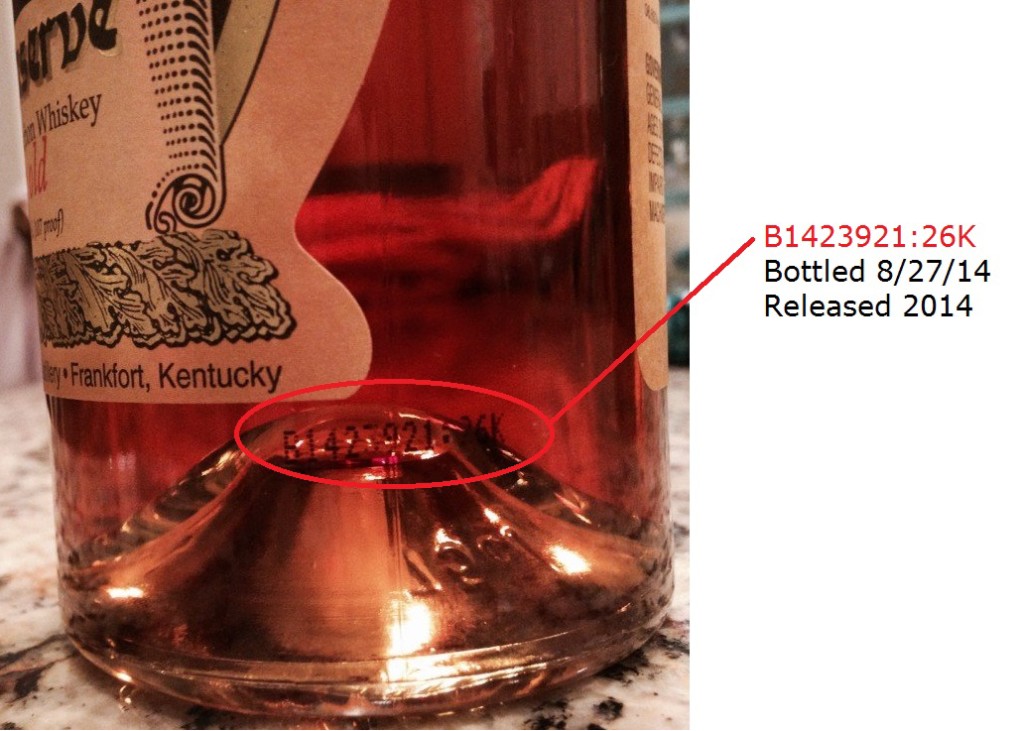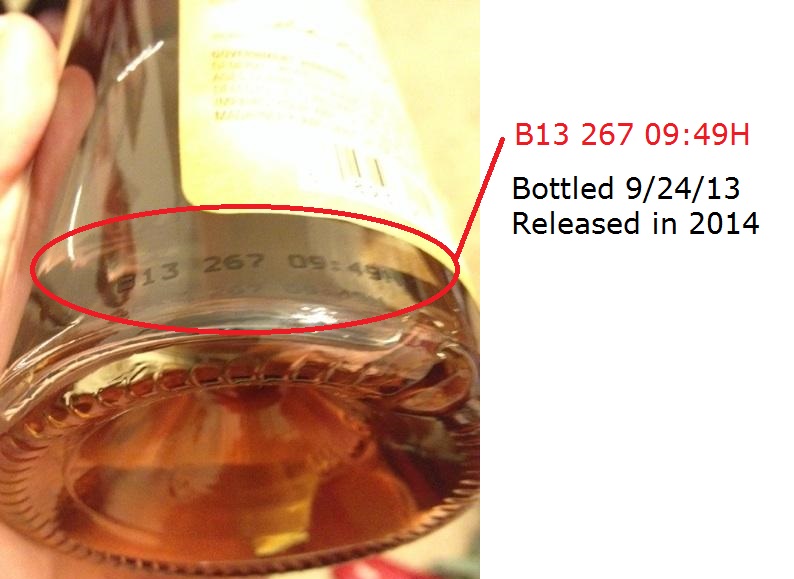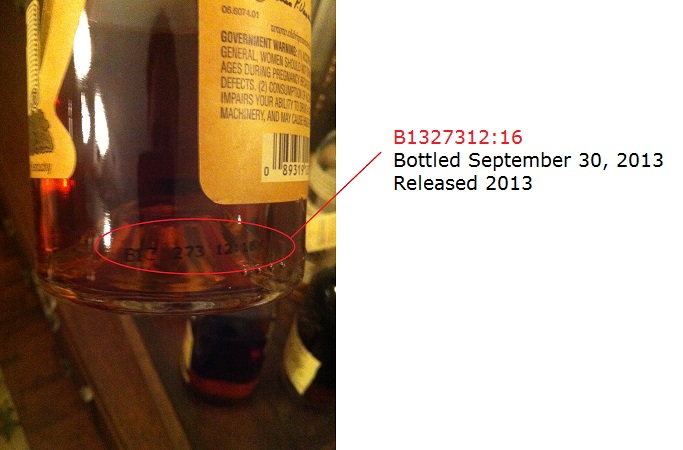Pappy, Laser Codes and Conspiracy Theories
2014 Pappy Van Winkle Laser Codes
Admittedly, this is probably the most sensationalized titles I’ve used for a post on Bourbonr but there’s a reason. With the Pappy Van Winkle release in full swing there have been multiple Bourbonr’s that noticed the laser code on their bottles were 2013. In fact, there have been several states releases composed only of laser codes reflecting 2013. This led to speculations and accusations of Pappy hoarding (a felony in the bourbon world) aimed at retailers, distributors and Buffalo Trace (BT) themselves. Questions began to fly! Was Illuminati involved? Does Skull & Bones control the Pappy distribution? Did Dick Cheney have anything to do with this? All valid (sarcasm) questions so I decided to hunt for answers.
First, here’s some background from WhiskeyID about the Pappy Van Winkle lasers codes:
Date Codes
Dating Van Winkle bottles post-2007 is made relatively easy based on “laser codes” or “dot matrix codes” printed onto the bottles. These codes indicate the bottling line, date, and time the bottle was filled, but can sometimes be difficult to find and/or read. The date codes are usually printed on the back of the bottle below the label, though occasionally they’re above the label or under the label itself. A bright flashlight shining though the bottle from the other side will often aid in finding the code.
There are two versions of the date code layout, each with its own decoding schema:
Pre-2012: K2250910:22
In this example, the K = the bottling line, 225 = the 225th day of the year, 09 = the year bottled, 10:22 = the time bottled in military time.
2012 and on: B1312011:11K
Here, the B = Buffalo Trace, 13 = 2013, 120 = the 120th day of the year, 11:11 = the time bottled in military time, K = the bottling line.
Prior to 2007 Buffalo Trace wasn’t using Date codes, so it’s a little tougher. You can see the timeline for more clues.



Initially, I assumed there was a bottling done in late 2013 and it was held by Buffalo Trace (BT) until 2014. This seems plausible and completely reasonable since Pappy Van Winkle makes up a very small percentage of what is bottled by BT each year. The problem is some of the bottles released in 2014 have laser codes very close to the dates of the 2013 bottling. Was someone hoarding bottles?
I reached out to Buffalo Trace about this issue and their response was about what I expected “Some of this year’s release were bottled in 2013, so the B13 would not be an anomaly to find. We will often bottle products as the bourbon is ready to bottle and we have space in our bottling schedule”. As it turn’s out Occam’s Razor proves true and the simplest explanation is the correct one.
While this isn’t as scandalous as someone hoarding large amounts of Pappy would have been it still is interesting. By my own rough estimates about 15% of this years release has had a “B13” laser code. Bottling that much Pappy a year early doesn’t exactly scream “WHISKEY SHORTAGE” either. The majority of B13’s appear to be on Pappy 15. These are probably bottled early because of the volatility in aging bourbon over the 15 year mark.
43 comments
Interesting read. Thanks Blake!
I have a 2013 15 yr pappy for sale please email about purchase live in Florida willing to ship.ronserpaio@yahoo.com
Scam.
I have lotB bottle with L22223C1. Is that legit as there is no B?
Mine starts with L also. Bought at Costco.
Good info, Blake. I got a Rye and also a Lot B in Illinois that were different years. Rye was a 13 and the Lot B was 12 laser code. The store only got 10 bottles and two of my buddies got a 15 and a 23 and they were the 14 code. I’m positive the store didn’t hold them, they sell them for MSRP, so I was figuring the distributor probably holds a few bottles a year back for special reasons and the 12 had been sitting there for a bit.
I purchased a Pappy Fam Rsrv 20 in Fresno,CA in 05 or early 06 ..don’t remember when..still in my closet. No laser code .
Definitely interesting. I wonder how many people will be paying some sort of premium on secondary sites for a 2013 pappy that is a 2014 release. Also, what does this mean as far as consistency across all 15 year?
I have a Pappy 23. Can anyone help me decipher your bottler?The laser code:
L180610107: 27N Any help would be greatly appreciated!
I mentioned this to you previously Blake but all 3 PVW20s that I purchased in Kansas had 2011 bottling codes. Very suspect to me.
I have 2 friends that both ended up with PVW20’s this year in AZ, and both had laser codes that showed a 2011 bottling. A friend in California snagged a Weller 12 year, also a 2011. Weird stuff.
Lucky friends, very hard to get a hold of in AZ this year .
Scott, guy I know (who i believe is a mutual friend of ours) got a bottle of 20 dated 2011 as well in the KC area.
Hey Pat. Yes, I think I probably know who you are talking about. Haha. It wouldn’t surprise me, 3 different stores and cities all with 2011 codes. Not that I’m complaining since it’s Stitzel-Weller, but it does seem odd.
Great article!!!
Thanks for the article. Clears up why my 15 year is stamped 2013!
I am in agreement that it does not seem scandalous given that the codes are intact from the actual bottling, otherwise they did not lie and put a 2013 code on a 2014 release. However, depending on how much emphasis you want to put on year to year variation within the same line, one or the other could be considered the “better” catch. I think the real story here is that BT is likely trying to manage the consistency of the year over year releases by holding some back when they know or can predict that the following years allocation of barrels won’t meet projections. So for example, rather than just distribute every drop allocated for 2013 in that years bottling, BT may say let’s hold back 15% of those bottles so that the 2014 release won’t even smaller than anticipated and therefore frustrate Pappy lovers even more.
I just checked the date code on my 2014 release Pappy 20 yr and found the following: N2811110:23. I was confused because I expected to see a post-2012 date stamp. Just like Scott and Pat, however, my Kansas City area (Olathe, KS) Pappy was bottled in 2011.
Hi will you help me date/ verify these PVW 15year? Have 2 btls. Thank you for your help.
B1618121:084
Blake, thank you for this educational article. I immediately went to look for the laser code on the Pappy 23 I purchased last year and cannot find a code anywhere on the bottle. Can anyone tell me if I should be worried?
FYI I bought my PVW 23yr. at Buffalo Trace in 2006. It is signed by both Julian and Preston in gold marker and there is no code on the bottle. You just may have an old pappy. Hope this helps.
Finally……someone with the courage to come forward with the Dick Cheney connection!! LMAO
Look at you Mr. Nancy Drew!
>Trevor: Should you be worried? Only if you paid too much…which is more than likely 🙁
I got a bottle of 12y last year in 2014 and was lucky enough to get another 12y this year 2015 but strangely both are from the same batch and laser code in 2013. I thought that was super strange
I have a bottle 2008 23 yr old ser# starts with a j ?
J0390807:46
That’s the bottling line
I have a code on a 20 Year Pappy I cannot identify. Can anyone help? The code is L192700107:25M
Nothing I’ve read matches the extra digits found in this code.
Hi! How about a bottle that starts with a K on the serial? “K2951106:35”. Does this make sense?
Also, would you believe it if the same bottle, for a 12 year old “lotB” is going for 128$?
I have a bottle of Van Winkle 12 year Lot B that I can’t seem to pinpoint a date on… It has no laser coding so that tells me pre ’07. Addressed in Frankfort, not Lawrenceburg, so that puts it post ’02. Any suggestions on how to get an exact bottle year?
I have the same issue with my 20. No code, but labeled Frankfort.
Got me a bottle of 15. Laser engraved L181310107:527. Purchased at liquor store for $179.
Just picked up bottle L181350110:147. Any help decoding?
2018
What does the L mean as the first letter?
I have a bottle that was given to me for my wedding in 2012. I have no idea how old it is because I cannot find the laser code. Is it possible that it’s older than that and had no code put on it? I want to sell it but I’m worried about it. Anyone have some insight?
Does anyone know what the rest of the numbers mean? I have a 2018…. L181350107:197 – can anyone tell me what the rest of the numbers mean?
did anyone reply to EZ’s decoding question ref what exactly all of the numbers mean?
Anybody have a botched laser code. I won one at Kroger and it looks like the bottle moved during the laser engraving.
I have two bottles of Pappy 15 with NO laser code etched on them. Is that possible that bottles were produced but did not get a laser code?
Mac, I’m currently doing the same research for a friend who has a 20yr bottle starting with L.
From what I have determined here is how I believe you read your code:
L – Bottling Line L
19 – BOTTLED in 2019 – Back up 20 years and you get a DISTILLED date of 1999 (non-BT juice)*
270 – Bottled on the 270th day of the year (in 2019) That would be September 27, 2019 (Fri)
0107 – Bottled at 01:17AM (24 hour Military time)
25M – Unsure. My research suggests that this could be a bottle number
*Buffalo Trace began distilling Pappy Van Winkle under an agreement in May 2002. Therefore the reason your label reads Bottled by Pappy Van Winkle in Frankfort, KY, not Distilled, Aged and Bottled by Pappy Van Winkle in Frankfort, KY as my friends other bottle which is a 15yr Pappy states (Distilled, Aged & Bottled in Frankfort, KY – i.e., Buffalo Trace Distillery).
I hope this helps (and is correct!)
Scientific support for a theory comes not just from the fact that it explains the evidence, but also from the fact that it is the best explanation of the evidence, where a theory is “better” to the extent that it is more straightforward, elegant, and economical than its competitors.